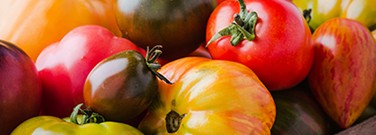The Secret Genetic Life of Tomatoes
By Christina Phillis
Tomatoes come in seemingly endless varieties — from small, red grape tomatoes to plump, purple kumatos. Scientists from the Howard Hughes Medical Institute set out to better understand how these different strains came to be by performing one of the most comprehensive plant analyses ever conducted. Their study, published in Cell, identified hidden mutations within the genomes of 100 types of tomatoes.
Earlier studies showed that mutations exist, but there had never been a way to study their impact until now. Equipped with this information, researchers could create new varieties or improve upon existing ones.
Tomayto, Tomahto
The physical characteristics of an organism, like whether a tomato is yellow or red, can be altered by mutations within the DNA in their cells. Previous studies focused on smaller mutations, like swapping a single nucleic acid for another. This study focused on making larger changes like copying, deleting, inserting, or moving long sections of DNA to another location in the genome.
While mutations can be identified using genetic sequencing, technological limitations have made it difficult to decipher longer sections of DNA. Using a technique called long-read sequencing, the team was able to identify more than 200,000 structural mutations.
Only a small number of the mutations identified were found to influence flavor, weight, or other important characteristics. Most mutations didn’t alter the genes that affect traits, but more often altered the mechanisms that control a specific gene’s activity — like the gene controlling tomato size.
The Bigger the Better
With this information, the team was able to alter fruit production by making copies of a gene. Plants with three copies of the gene made 30 percent larger fruit than those with a single copy. Additionally, they showed that multiple structural mutations together might be needed to breed a major harvesting trait into modern tomatoes.
Armed with these insights, breeders may be able to create new varieties, make existing ones larger, or make other improvements. As researchers plant the seeds for bigger and better vegetables, it will be fascinating to see what crops up.
Discussion Questions
- If you could change some characteristics of your favorite fruits or vegetables, what would they be and why?
- How can altering the food we eat improve it? How might this help to improve our eating habits?
Vocabulary
- Mutations
- Genomes
- Gene



